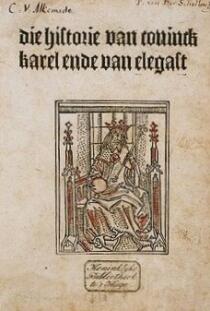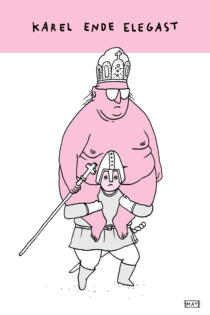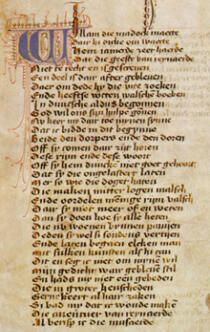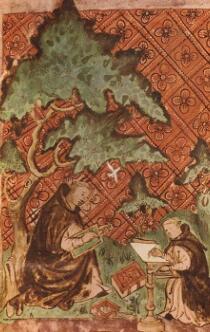The story opens with Charlemagne asleep in his castle in Ingelheim. An angel commands him three times to get up, arm himself and go out thieving. Charlemagne is alarmed: who has sent him this message and why does he have to steal? The fact that the command is repeated three times convinces him of its divine origin, so he decides to obey, even though it means becoming a thief. Charlemagne – like the reader – has no idea why God has commanded him thus but he does know that it is a matter of life and death. He departs unnoticed and enters the threatening forest alone.
There he encounters Elbegast, a former vassal whom he had severely condemned for an offense but who has nevertheless remained loyal to his former liege lord. Charlemagne introduces himself as Adelbrecht, professional thief, and Elbegast does not recognise him. When Charlemagne proposes that they break in to the king’s castle – into his own home, in other words - Elbegast indignantly refuses. They decide to break into Eggermonde, the castle of Charlemagne’s brother-in-law Eggeric. Elbegast uses magic to gain entrance to the castle and witnesses an argument in Eggeric’s bedroom between Eggeric and his wife, Charlemagne’s sister. This is how Elbegast learns that Eggeric intends to kill Charlemagne the very next day. Elbegast tells Charlemagne/Adelbrecht what he heard, but that he does not want to warn Charlemagne himself for fear of his anger. Charlemagne then offers to be the one to alert the king. The next day, Eggeric is disarmed and Elbegast has his reputation restored.
Within the limited scope of the story, the poet manages to build up real suspense. He/she does this, for example, with the break-in at Eggermonde castle, but also by delaying the revelation – that Charlemagne had to steal in order to discover Eggeric’s murder plan - for as long as possible. There are also comic moments, such as when Charlemagne tells Elbegast that he wants to break into the castle using a ploughshare (thereby revealing that he is not a professional thief).
The tale is clearly structured, with the locations of the story laid out neatly. Each setting corresponds with the appearance of one or more characters. It starts in Ingelheim (Charlemagne on his own), moves to the forest (Charlemagne and Elbegast) and then to Eggermonde (Charlemagne, Elbegast, Eggeric, Eggeric’s wife), to then end up back in Ingelheim (all characters, Charlemagne the king surrounded by his court). This structure is supported by a subtle use of various narrative techniques, including the “double lens”: a plot point is first described by the narrator in a sober, objective way and then emotionally and subjectively clarified by a character, which gives it greater psychological depth.
The moral of the story? By obeying God’s command, Charlemagne realises that he had judged Elbegast too harshly and was wrong to trust Eggeric. By acting as a vassal of God, the supreme liege lord, Charlemagne has learned to be a better liege lord himself.






